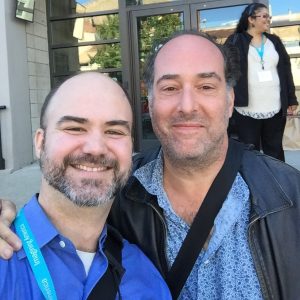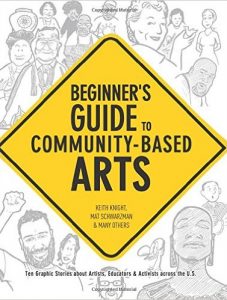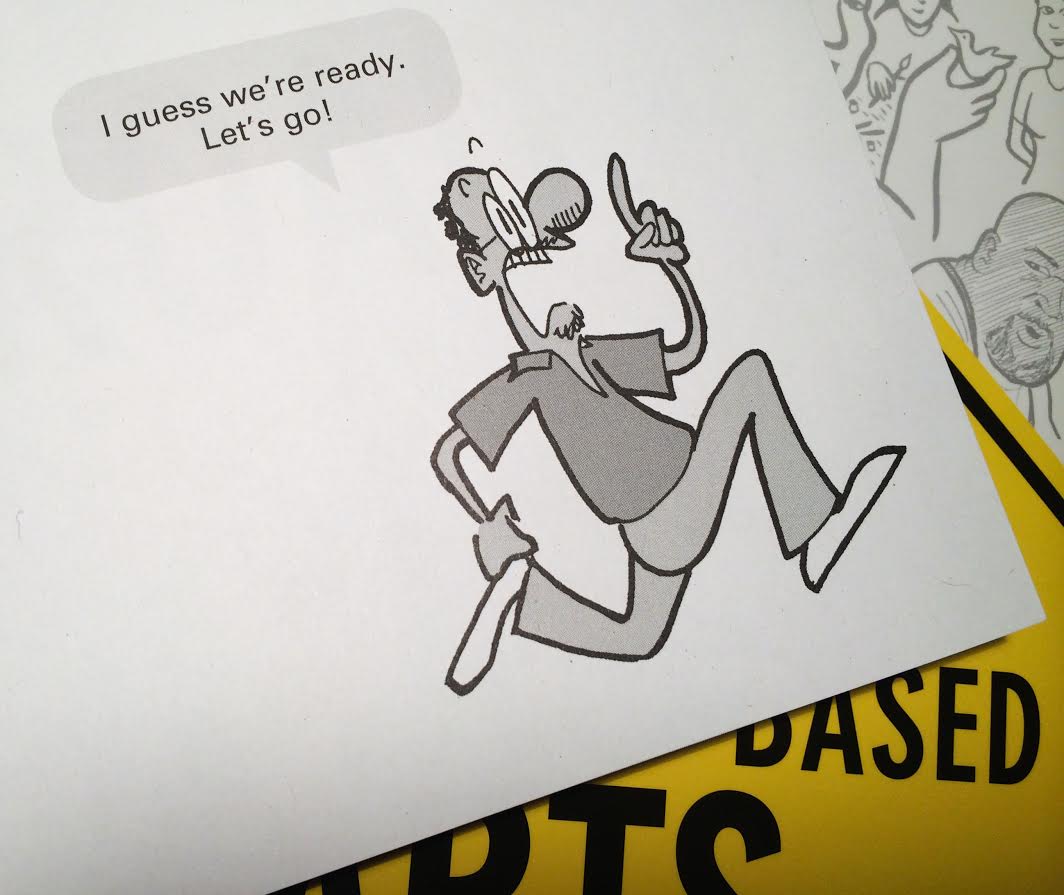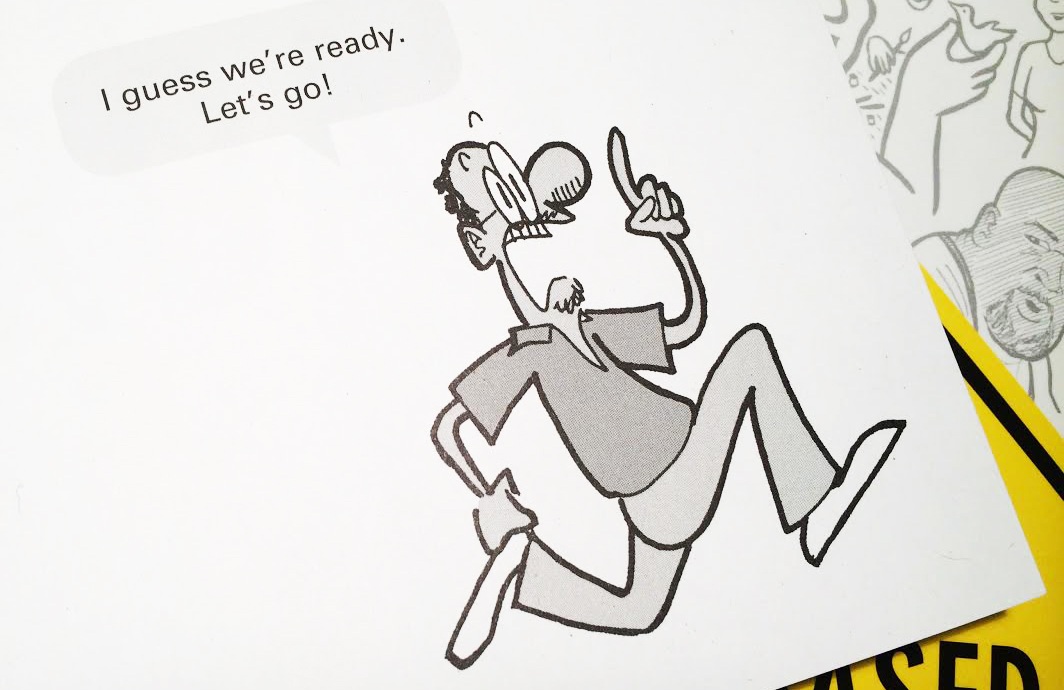When I was starting out as a community-based arts educator in Chicago, the Beginners Guide to Community-Based Arts — with its welcoming, bright-yellow cover — was one of the most thumbed-through books on my shelf. Recently I had the chance to speak with one of its co-authors, Mat Schwarzman. We discussed his background in political theater, the CRAFT model of community organizing, working with cartoonist Keith Knight, and his plans for a series of creative youth development trainings across the country.
I’d like to start by asking you about your background. How did you first get into the world of community-based arts and cultural organizing?
I went to college for theater, and then got a job as company manager for a touring theater company in Philadelphia. It was called the Big Small Theater, based on a quote from Chinese philosopher Lao Tzu, “Deal with the big while it is still small.” This was a political theater company that created and performed original work around social issues, frequently in partnership with social justice organizations in Philadelphia. I was very lucky to get that job so early in my career, and to be exposed to the notion of artists partnering with social justice organizations.
Do you remember any of the shows?
Sure. One of the shows we did was called The Thinking Heart. It was based on a book by the same title about a romance in Nazi-dominated Holland in the 1940s between a Jew and a Christian. The play was about what people do when they think that the end of the world is nigh. That piece was created in partnership with the local American Friends Service Committee. Also, my first project there was working on street theater with the Philadelphia Zoo, focused on ecological issues for kids.

I ended up co-organizing a conference in Philadelphia on the history of arts and social change in the United States. It was called Voices of Dissent. This was 1987, the 200th anniversary of the US Constitution, so we used the concept of free speech through the arts. The conference was very successful. It spawned a book called Reimaging America: The Arts of Social Change, an anthology of articles published in 1990 by New Society Publishers.
In many ways that conference has driven the rest of my life and my career. I married the conference organizer. I live in New Orleans because John O’Neal lives here, and he and I basically got to know each other through that conference. I lived for a while in San Francisco because I met Joe Lambert from the Center for Digital Storytelling at that same conference. I got a job in San Francisco at a place called New College of California, and I ended up co-founding one of the first undergraduate majors in arts and social change in the country.
It was this kind of embarrassingly wonderful faculty. There were just oodles of arts and social change leaders in San Francisco. Rhodessa Jones was on our faculty, Ronnie Davis, founder of the San Francisco Mime Troupe, Joe Lambert, Keith Hennessy who’s very active in Alternate ROOTS now, Sonia BaSheva Mañjon and a bunch of others. The program operated for a couple of years, but unfortunately after six years there I was summarily terminated.
What happened?
I was kind of a victim of my success, in the sense that the enrolment for our program was going so well that the leadership of the college started paying attention to us. They got in our way, started fomenting conflict between the faculty in my department. It was a lot of ego stuff, which I didn’t handle all that well either. At that point I ended up creating a new organization. I wanted to go younger, work with high school students, so I created an organization called East Bay Institute for Urban Arts.
Is this the one you founded with Rinku Sen?
Correct. It was an outgrowth of the Center for Third World Organizing. They wanted to develop more youth leaders, and they felt like the arts would be a great way to do that. I was really interested in working with younger people and also having a more systemic relationship to direct action efforts — trying to get deeper into what it is we mean by “social change” when we talk about arts and social change. Rinku really taught me an enormous amount about that. Their methodology was called CRAFT (Contact, Research, Action, Fundraising, Training).
I was intrigued by the acronym because of the idea that there is a craft of community-based art. To me, a craft is somewhere between an art and a science. Sometimes I think we throw a false mysticism into the work, and there is resistance to approaching the work as a craft. It’s supposed to be intuitive and non-linear and that’s all true. But there are basic ideas that undergird much of what we do. Without that acknowledgement it’s really hard for people to collaborate. If all collaborators are going to have an equal stake, the other partners – the educator, the organizer – also need to have a sense of “Oh, this is the process we are going to go through.”

I was in graduate school at that time and ended up writing my dissertation about how one could adapt the CRAFT methodology for use in community based arts practice (Contact, Research, Action, Feedback, Teaching). My dissertation was a case study of a yearlong project we did in Oakland. Community organizations were trying to pass a budget a line item in the Oakland city budget to go toward youth development. Young people in our organization developed all the visual materials from the campaign. The budget line passed, and it was a very powerful experience.
Urban Arts lasted until 2000, and then my wife Mimi Zarsky and I decided to move. I got this job here in New Orleans at the National Performance Network. It enabled me to go from the dissertation to a publishable book, and that’s the Beginner’s Guide. It’s a series of demonstration case studies about the ideas that were in my dissertation, translated in such a way that a high school student can read them, so a high school teacher could use it if they wanted to.
How did you end up getting hooked up with Keith Knight for the book?
Keith had done some workshops with us at Urban Arts working with the young people. That’s how we got to know each other a bit. And then it was my wife’s idea to do it as a cartoon. I collected comics as a teenager and still have my comic book collection from that time, and so when Mimi heard that my goal for the book was to take all this stuff about community-based art that has been written about mainly in academic or intellectual circles, and put it in hands of the grassroots community whose issues are often the ones focused on, she suggested doing it as a comic.
Even though I did the research, and I wrote the draft text for everything, it was Keith’s genius to make it readable and interesting and to make connections. It’s really information design. He translated what I wrote into another medium, and in so doing kind of reflected back my thought process to me. That was just eye opening. Because Keith is so busy, I’ve tried to work with other cartoonists and it hasn’t gone nearly as well. The fact that Keith understood the ideas as a practitioner, not just as an illustrator, was crucial.
How long did it take you and Keith to put the book together?
5 years
Did you travel around interviewing people? Because that was not the case study that was in your dissertation.
Correct. My goal in choosing artists and arts groups to cover was to find ideal exemplars, almost like Biblical or comic book heroes who could act as universal object lessons. So we organized a national advisory council of about 12 or 15 people who were all really active leaders in cultural, political, or educational fields, and we went through a process of probably about a year. We were looking at art form, political issue, part of the country, ethnicity. Each of the advisors made suggestions, we reached out to those artists to find out materials, and there was a lot of back and forth because I knew that each case study also needed to demonstrate a different concept within the overall CRAFT model. So there were some artists who I felt like had all the other requisite parts but weren’t a good fit for that reason. By the time we went to do the research it was relatively straightforward. It was still very hard, but we at least knew what stories we were coming to tell.

Not being a professional graphic storyteller, I had a pretty steep learning curve. And not only was I working with Keith, but I was also working with a graphic designer named Christine Wong on the overall visual design of the book. While the graphic stories were the center of the book, I always knew I wanted to have other sections and wanted them to be visual as well. It was Christine that developed the design and layout and concepts for those front pieces and back pieces.
I believe the Beginner’s Guide represents more than just a model or approach but a different general theory for community based arts, a fundamentally different way of looking at the arts. So in the front of the Beginners Guide we include Three Premises of Community-Based Arts: (I) creativity is a muscle, (II) art is information, and (III) communities are cultures. To really understand the CRAFT process you need to also understand these basic ideas. “Creativity is a muscle” means that art is not a leisure or recreational activity. It’s a core genetic capacity that we have as evolved human beings. “Art is information” is the idea that art is designed to tell our most important stories, and that its political power comes out of the internal drive that human beings have to make and witness art. And then “communities are culture” is that idea that no matter how advanced or sophisticated we have become we still interact with a core group of somewhere between 150 and 250 people in our daily lives, and our relationships are governed by the signs and the symbols and the rituals and the stories that circulate in that community. Community-based artists are attuned to those signs, symbols, rituals, and stories and how they interact with specific audiences and communities.
When you’re book first came out, how was it received?
That’s a funny story. I always knew I wanted the book to be the initial point of contact for what would become an ongoing learning community of teachers and teaching artists that work with young people. So, my plan was to organize a series of professional development workshops and things that would go along with the book and keep me busy for several years. The timing of publication, along with the place where I live being New Orleans, made that impossible. My author’s copies of the book arrived at my house on August 27, 2005, two days before Hurricane Katrina hit land. I took one copy with me as I evacuated.
Unfortunately, because of Katrina, we ended up not really being able to run with that success like I wanted to. I’m very much of a place-based person, and I had always envisioned this book being useful here locally after. I tried to make that work, but I found that the school system was so chaotic and unformed — they basically fired all of the teachers. I got some funding to go into the schools to do professional development, and first of all, they didn’t have their shit together enough to make use of PD. They were just worried about getting a teacher to teach these 30 students who otherwise didn’t have a teacher. Second, the young people were the ones who seemed to need more of the help. So I ended up developing a direct service youth program called Creative Forces, a teen theater company that created and performed arts and social change plays, similar to what I did myself in Philadelphia. They did plays about adolescent asthma, adolescent obesity, violence against adolescents, stuff that was directly related to them and their lives. A lot of it was synthesizing stuff from the beginner’s guide into a single program.
That ended in 2010 and I had to get a job, so I was an administrator for five years working for this very worthwhile non-arts related org here called New Orleans Kids Partnership. That was about getting youth organizations to collaborate. It was very satisfying, but I completely burned out on it.
One of the unintended benefits of Katrina was that back in 2005 Keith and I ended up touring for a solid month. It was Keith’s speaking tour, but because I was without a home I ended up going with him and turning everything he was doing for himself into something about our book also. So I’ve had a lot of opportunities to talk about it with people. The book came out at a time when graphic novels were also gaining more validity, and there were more of them. I think we were part of that wave. So we didn’t know whether it was going to be adopted and it was — we got very positive feedback form it.
So 12 years later, I now want to see what, if anything, I can revive of my teaching and professional development career. In the meantime the beginners guide had kept selling, and it is by far our publisher’s biggest title, it was the first title New Village Press published, and it has continued to sell more than any other title. It’s in its fourth printing now, there’s something between 8 and 10 thousand copies sold, which within the world we operate in is not bad.
I would bet a lot of copies of your book are in the hands of people who use actually use them in their work, which is different than selling a million Stephen King novels.
Yeah. One of the things we started hearing early on, and which has become like a badge of honor, is that it’s the one title that’s stolen from people’s libraries more often than any other. And call me crazy, but I do think the comics have that power. They just draw you in, like a choir. It’s almost impossible to look away once you see what’s happening.
The other thing that surprised me is that no one else in this field has taken the concept further. So the next step for me is to circle back to a lot of the hopes that I had in 2005 when the book first came out, and trying to make those things happen with the benefit of 12 years of the book having been out. While I wouldn’t have chosen it to have it happen this way, I’m trying to make the most of it.
I’m cementing a partnership with Xavier University here in New Orleans, and they’re going to be most likely launching a new certificate program in the summer on the CRAFT of creative youth development. It will focus on training teachers and teaching artists and community organizers how to use the book, and the CRAFT methodology. I’m also thinking about developing an app for your tablet based on the section of the book called the “craft circle.” It is essentially a cookbook of games and exercises and projects that use the CRAFT methodology, with the idea that people in the certificate program will be able to contribute into the library as well as use what that they find inside it.
As you look back at the book, have your ideas have changed much in the last 12 years?
No, I would say they haven’t. However, I knew that when it was published the book was not really done. I’m very excited about the opportunity to go deeper into the ideas in the book, and to do another edition of the book that is articulated with the app, so that we can have a more dynamic relationship between the content of the book and whatever knowledge base I’m able to collect beyond the book. Of course, none of this is really funded yet.
That’s exciting. There is something about that book that is very welcoming, very friendly — the yellow cover that reminds me of those “for dummies” books.
Absolutely. When I was coming up with the book, my wife was reading Dream Weaver for Dummies, and she said, “You should do something like this.” That is what drove the whole concept. It didn’t make sense to do community based arts for dummies.
No, that would be going a little far.
I feel that the greatest strength of the book, and something I want to keep in this next phase, is welcoming new people into the fold. The CRAFT model has only so much use value. I think of it as being like a training wheel function. If you don’t understand this type of work, you can use this stage model. Because the reality is that community-based arts is not really linear. But my argument is that if seeing it as a linear process helps you do it the first time, then why the hell not. I see it as a pragmatic tool for collaboration more than anything else. It enables the artist and the educator and the organizer to align their processes toward the same endpoints.
I don’t think the next step is doing the Advanced Guide to Community Based Arts. I want to find new and better ways to help beginners. At Xavier University, the next group of beginners I’m going to be working with is science and math teachers. The new program will offer a 3-unit, 30 hour certificate in the CRAFT of creative youth development. It would be like 10 hours of reading and preparation, 10 hours of face-to-face time where I would come to your community and do a day long workshop, and then 10 hours of follow up work writing a plan that you can use as the guts of a grant proposal. That’s the introductory level. Then there’s a second certificate which is Creative Youth Development in the Science and Math Classroom. That’s an 80-hour, 8 unit certificate designed for science and math teachers who are required to take continuing education. It is a way to help them learn how to integrate community based arts into the classrooms, and to partner with artists and organizations in the community.
It seems like you’ve jumped back into community based arts and you’re going full throttle with what you thought you’d be doing ten years ago. How are you feeling about it?
I feel very good. It’s a funny thing. Because I’m underemployed right now and talking about a project that I don’t have funding for. And I’m 56. So on the one hand I feel kind of crazy to be doing this. On the other hand, it feels very right to be doing that at this particular age because if I had been able to do it ten or twelve years ago when the book came out several things would have been to my disadvantage. One is that community based arts as a field would not be nearly as well known as it is now. Another is that online technology in terms of distance learning was much rougher 12 years ago. I also now have 12 years of data – I don’t have it in my hand, but if I start reaching out to people who have been using the book I’ll be able to gather a lot of great new information about how to teach people how to do the work. I don’t think I would have chosen for it to happen that way, but I can see how if I take advantage of I, the stars are really aligned in my direction.
So what’s next?
First, we are very proud to announce here for the first time that New Village Press will be publishing a revised 2nd Edition of the Beginner’s Guide in September 2017. It will include updated information on all ten featured artists and a new introduction on the state of the field by Keith Knight and me. This should lead to a new round of speaking engagements and such around the country.
Second, I am working with some amazing collaborators at Xavier University of Louisiana to realize my dream of a learning community based upon the concepts and approaches from the Beginner’s Guide. Our goal is to launch an online continuing education certificate program for teachers and teaching artists in 2018. To stay informed, sign up for our mailing list at www.thecraftcircle.org.
One last question. How do you understand the concept of “cultural organizing?”
There was a class at New College in the Arts and Social Change program called cultural organizing in the early 90s, taught by Sonia Mañjon. At that time the idea was kind of a binary concept. On the one hand I think it was referring to the field of what we call arts administration, but from an organizing mindset. On the other hand, it was about the art or cultural component of the organizing process. The approach I have tried to take is the intersection between those two things: how arts admin is like organizing, and organizing like cultural work. To me it was always about creating art that is needed.


